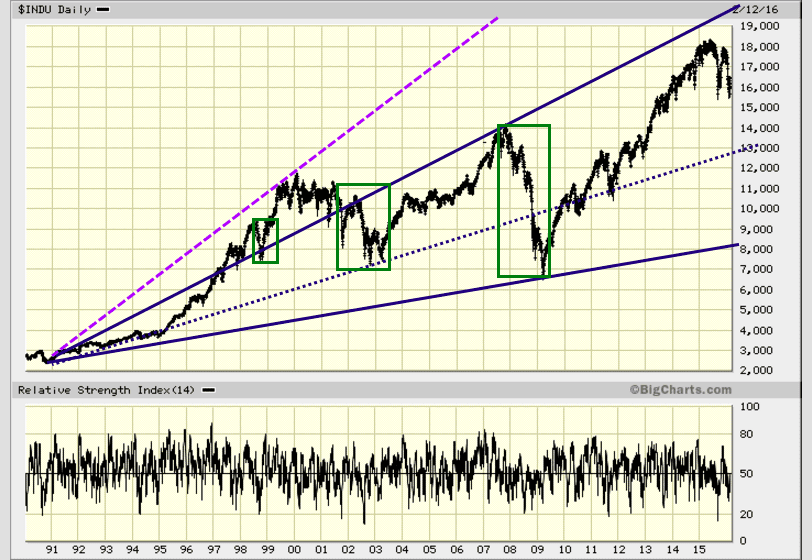Crisis Investing 101: Crashes Equate To Opportunity
Updated Sept 10, 2023
The Tactical Investor states that you should jump for joy if the trend is up or unchanged. In other words, buy when the masses panic and sell when they are joyful. This simple illustration explains why all sharp corrections or crashes or whatever the naysayers would have you believe are nothing but investment opportunities. That is really what crisis investing is all about seeing opportunity where others see disaster.
Look at the long-term chart below or any long-term chart of any primary index, and you will see that in every instance, the markets recouped their losses and trended higher. This begs the following question: for whom exactly are these Wall Street experts working? The answer is obvious: they sell their services to the highest bidder. In this instance, this happens to be the shadowy top players who know precisely when to sell and when to buy.
Remember, Crisis investing states that disaster has to be viewed through a bullish lens.
They know this information because they have used the same strategy dating back to the Tulip bubble (probably earlier). The idea is to create substantial fantastic stories of the carnage in store for the market when it starts to pull back. In doing so they sow the seeds of doubt into the masses, and when the groups are in doubt, it is easy to trigger a stampede.
Once the masses stampede, the logic goes out the window, panic takes over, and the top players come in and purchase all the leading stocks the groups are dumping for pennies on the dollar. Every Stock market crash is nothing but a repeat of Groundhog Day over and over again.
Turning Crisis into Opportunity: The Secret Code
Look at this chart carefully; most will see disaster every time the Dow Jones pull back strongly. They would falsely classify this as the end of the world, but in reality, it was nothing but a buying opportunity. When Fiat ends, and nobody knows when that day will occur, we might have to change our mantra. Until that time, robust corrections have to be viewed as buying opportunities.

This chart dates back to 1990. What do you see? Well, we will tell you what we see. There is no such thing as a crash? A market crash is a matter of perspective, and the masses always examine the situation with fear as their guide and stupidity as their master.
It is a crash only if one is stupid enough to wait until the top to commit all one’s funds, which the masses are famous for doing and if one is equally stupid enough not to trade without any stops in place and then close the entire position at or close to the bottom. Trend players never buy at the top; they always deploy most of their funds when the market is putting in a bottom.
The masses are doomed to repeat history because they never learn, and as a result, they can look forward to a lovely battered dog house when it’s time to retire.
Crisis Investing & Corona Virus Update April 2020
While it may have been scarier in 1987 and 2008, at least to Buffett, there’s no denying that it’s been a brutal stretch for investors.
The so-called Oracle of Omaha appears well-positioned to weather more market turbulence. At last count, Berkshire Hathaway was holding $128 billion in cash.
“Buffett did not amass his fortune by following the herd but by leading it,” RIA Advisors strategist Lance Roberts recently wrote in a blog post. “He is sitting on a $128 billion in cash for a reason. Buffett is fully aware of the gains he has forgone, yet still continues his ways. Buffet is not dumb!” Full Story
You have it from Buffett so what are we doing at the Tactical Investor?

The masses are in a state of hysteria, so we will load up on quality stocks, for we know that 15 to 24 months from today, the multitudes will be weeping tears of blood. They never learn; they run every time the market crashes, so the rich get richer, and the Crowd gets poorer and dumber.
One should understand that the route of today’s problems is Fiat money, and as the money supply increases, so will the number of issues facing this world. As the difficulties arise, so will the opportunity factor, but for that, one needs to stop falling for conspiracy-type theories and focus on taking actionable steps. 10% of the populace thinks outside the box, but roughly 3% put this information to use. The rest fall into the “conspiracy storytelling camp” or the “resistance camp”; both positions are all talk without the follow-up action.
Crisis Investing Success: Navigating Mass Psychology with Contrarian Wisdom
Contrarian investing can be a powerful strategy when executed with knowledge and discipline. Here are a few additional points to consider:
1. Fundamental Analysis:
Contrarian investing often involves analyzing a company’s fundamentals to determine its intrinsic value. By assessing factors such as financial statements, industry position, and management quality, you can identify opportunities where market sentiment may be disconnected from the underlying value of a company.
2. Risk Management:
Contrarian investing carries inherent risks, as going against the prevailing market sentiment can result in short-term losses. Implementing proper risk management techniques, such as diversification and position sizing, can help mitigate these risks and protect your portfolio from excessive exposure to individual investments.
3. Patience and Long-Term Perspective:
Contrarian investing requires patience and a long-term perspective. Market sentiment can take time to reverse, and it’s important to give your investment thesis sufficient time to play out. Avoid making impulsive decisions based on short-term fluctuations and focus on the long-term potential of your investments.
4. Research and Due Diligence:
Thorough research and due diligence are essential when practicing contrarian investing. Analyze the reasons behind the prevailing market sentiment and evaluate whether there are valid fundamental reasons supporting your contrarian view. This analysis will help you identify potential opportunities and make more informed investment decisions.
5. Flexibility and Adaptability:
Contrarian investing requires flexibility and adaptability. Market dynamics can change, and it’s important to reassess your contrarian positions if new information emerges. Stay open to adjusting your strategy based on evolving market conditions and be prepared to exit an investment if your thesis is no longer valid.
6. Learn from Mistakes:
As with any investment approach, learning from mistakes is crucial. Not all contrarian investments will be successful, and it’s important to evaluate your decisions and learn from any missteps. Use your experiences to refine your contrarian investing skills and improve your future decision-making.
Remember that contrarian investing is not foolproof, and it carries risks like any other investment strategy. It requires a deep understanding of market psychology, careful analysis, and emotional discipline. Consider consulting with a financial advisor or experienced investors who have successfully practiced contrarian investing to gain additional insights and guidance.
Overall, by mastering emotional discipline, understanding market psychology, and implementing sound investment practices, you can increase your chances of success as a contrarian investor.
On a lighter note
What do you think of this video? Is it cute, or funny? if you did, please comment at the end of this article. Videos with positive emotions are said to lower one’s stress; they provide one with the ability to view things from an objective perspective. When feelings do the talking, logic does the walking, and the result is far from healthy or pleasant. Please comment below and let us know if this new approach interests you.
The original publication date was February 23, 2016, and it has been periodically updated over the years. The most recent update was on August 30, 2022.











